‘BATTLE OF THE BELL O’ THE BRAE’ |
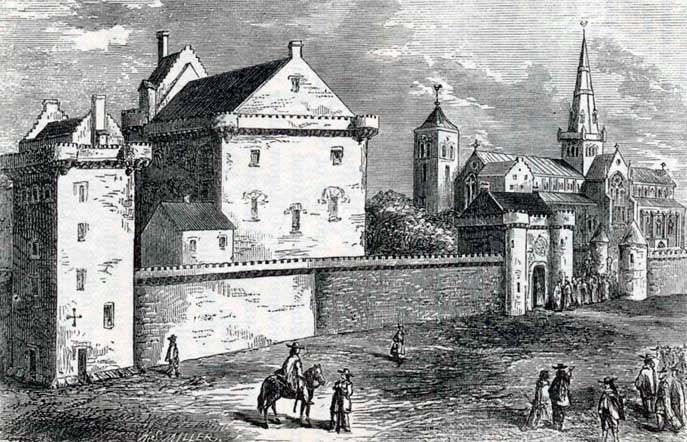 |
A view of the Bishop's Castle from the south west just before the Reformation in 1560. The Cathedral is in the background. |
| There isn't a great deal known of this alleged encounter but here we attempt to discover the facts about the ‘Battle of the Bell o’ the Brae’ and the history of the bridge over the Molendinar Burn to Glasgow Cathedral. |
Early Glasgow by Sir James D. Marwick (1911) |
| Blind Harry’s account of Wallace’s battle against the English in Glasgow at the end of the 13th century was retold in a book by Andrew Brown in 1795 and again in 1804 by Andrew Denholm and they had accepted it as fact. It is also mentioned by Dr. Cleland in his “Annals of the Town” referring to it as ‘The Battle of the Bell of the Brae’. |
Medieval Glasgow by Rev. James Primrose (1913) |
Primrose says that when Bishop Wishart, James the Steward, Robert Bruce and the rest of the Scottish nobility capitulated to the English army at Irvine on 9th July 1297, Wallace was infuriated, and according to King Edward I’s secretary, “proceeded to the bishop’s house” generally thought to mean Glasgow Castle, “and carried off all his furniture, arms and horses” This is possibly the same event referred to by Blind Harry, who has Wallace ride from Ayr to Glasgow and divide his force into two. He headed one half of his men and advanced up the “playne street”, understood to be present day High Street, near where it joins Rottenrow, where “for many a day was a steep and rocky ascent known as The Bell O’ the Brae”. Here Wallace clashed with the English, while the second section of Wallace’s men came up the Drygate and attacked the English rearguard. This surprise appearance of a second force had the effect of demoralising the English and resulted in a complete victory for the Scots and left Wallace in command of Glasgow Castle. Primrose says that the bridge that Blind Harry mentions which Wallace crossed is now known as (in 1913) Ladywell Street and was once known as ‘Wallace’s Brig’ One historian, a Mr. Pagan, in his “Sketches of Glasgow” in 1847, rejects the whole thing as a fable. From a personal viewpoint, although it must be understood that descriptions of events from so long ago have gone through many changes and embellishments, it is often the case that these embroidered tales usually evolve around a grain of fact, and as such, are worthwhile recording. Glasgow Castle was first mentioned in 1258 and its ruins were demolished in 1792 when the Royal Infirmary was built. The bridge replacing ‘Wallace’s Brig’ was built over the Molendinar Burn in 1833 and became known as ‘The Bridge of Sighs’. The burn itself was later culverted in 1873. |
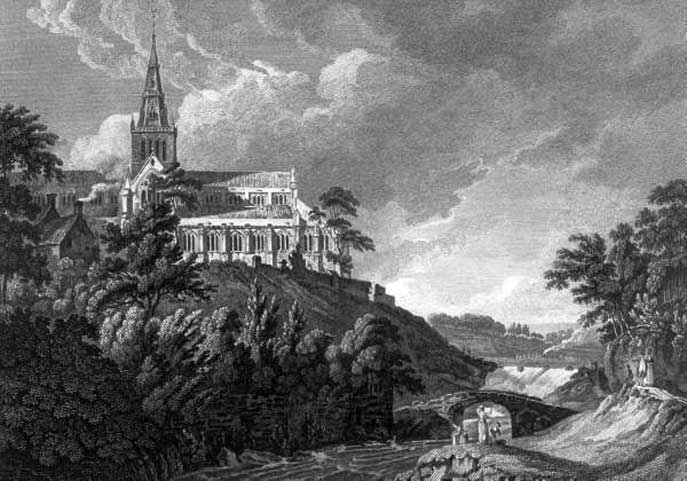 |
Glasgow Cathedral, with the so called Wallace Bridge over the Molendinar. From watercolour by Thomas Hearn circa 1775. |
Andrew Aird 1894 |
| Among the many places made sacred by the deeds of Sir William Wallace is the Bell o' the Brae in High Street. Wallace had vowed unceasing enmity to the English invaders of his native land, and his mighty sword had cleared a considerable part of Scotland from under their sway. In 1297, accompanied by 300 horsemen, he rode from Ayr to Glasgow, and, reaching the town, divided his small force into two companies, one of which marched up the High Street, the other making a circuit so that the two bodies would meet near the head of the street. Here the English, 1,000 strong, under Earl Percy, were attacked front and rear, and fled discomfited after their leader had fallen by the sword of the Scottish patriot. Wallace pursued them, and encountering another party of English near Bothwell routed them. Two months afterwards he fought and won the battle of Stirling Bridge. |
Extract from The History of Glasgow By Robert Renwick LL.D. and Sir John Lindsay L.D. in 3 volumes (1921) |
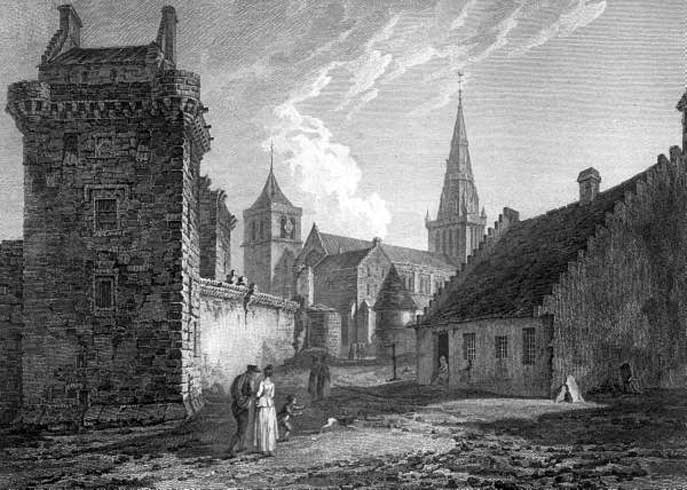 |
Engraving by William Byrne from drawing by Thomas Hearne of the Cathedral Church of Glasgow and Episcopal Palace.
|
To about this time may be assigned the encounter known as the battle of the Bell o' the Brae. An animated passage in the metrical narrative of Harry the Minstrel describes how Wallace overcame a body of English troops in the streets of Glasgow. "Out off the gait die byschope Beik thai lede, At that time, the open ground cast of the Blackfriars' Kirk and the woods and fields beyond, would afford the readiest route in the retreat to Bothwell. The narrative is true to the locality in outstanding features; and, keeping in mind that Wallace, from his early days, was well acquainted with the district, that he had the co-operation of the bishop, and was on intimate terms with his co-patriots, the monks of Paisley, [See The Abbey of Paisley, by Dr. J. Cameron Lees (1878), chap. x.] As a reward for the patriotism of the monks during the wars of Wallace and Bruce, the English burned their monastery in 1307 [Glasgow Memorials, pp. 28, 29).] who had dwellings and dependents in Glasgow, and that these dependents had the opportunity of knowing and communicating to Wallace the most favourable time and place of attack, it would have been strange if some attempt had not been made to molest the English garrison. |
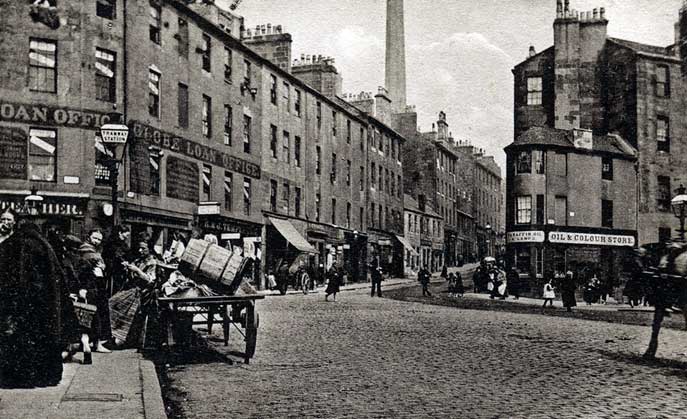 |
Bell O' the Brae, High Street Glasgow, looking North. |
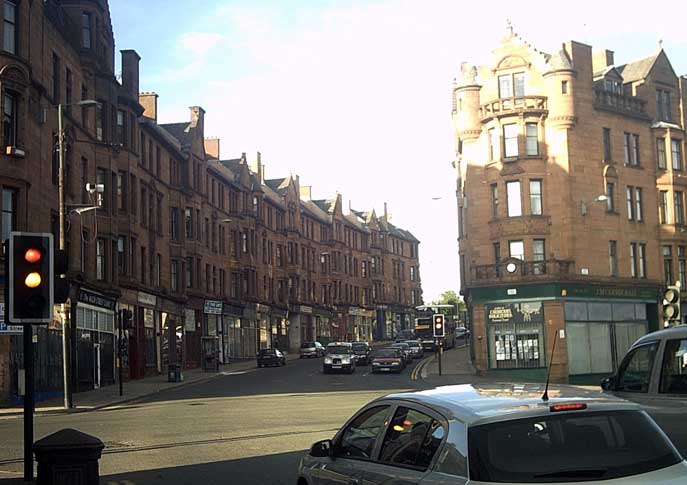 |
All the chief writers regarding the history of Glasgow, as a matter of course, give an account of the Battle of the High Street; in which the patriot Wallace fought and defeated the Southerns at the Bell o’ the Brae. Such accounts are derived, of necessity, with more or less accuracy, from the narrative given by Blind Harry in his national heroic poem of Wallace. MacGregor (History of Glasgow) furnishes two accounts, one from Brown’s History of Glasgow, and the other from Carrick’s Life of Sir William Wallace. Both of these versions are in prose, whereas, of course, the original is in verse. Blind Harry’s account is manifestly taken from tradition, and although it is probably right in the main, it is certainly mixed up with some apocryphal details. However, Wallace certainly captured the Bishop’s Castle, or palace, in Glasgow in 1297, and King Edward I., with reference to Bishop Beck’s flight, sneeringly wrote: "Anthony is on his travels." Blind Harry places the Battle of the High Street on the morning after the Burning of the Barns of Ayr. |
The account which follows is from Blind Harry’s original, here rendered into modern English: "When Wallace men were all together met, |
We'd like to thank ELECTRIC SCOTLAND for the above article |
| © Society of William Wallace 2007-2025 | The Society of William Wallace is a Scottish Charitable Incorporated Organisation Registration number SC045959 |
